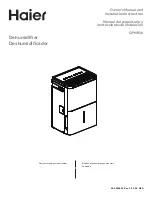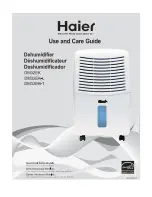
ZEKS Eclipse
TM
90-5,000ZPB Desiccant Dryers
www.zeks.com
5
6.1 INTRODUCTION
As described in SECTION 1, the ZPB series dryer is used to
remove water vapor from compressed air by diverting the air
fl
ow alternately between two towers that are
fi
lled with desiccant
material. While one tower processes the compressed air stream,
adsorbing water vapor, the opposite tower is regenerated by
desorbing the water vapor accumulated in the previous cycle
and venting it to atmosphere. Refer to SECTION 14, PROCESS
AND INSTRUMENTATION DIAGRAMS (P&ID) for a visual
representation of the drying and regenerating cycles.
Timing of the drying and regenerating cycles is automatically
controlled by a Solid State Timer (SST). An optional
programmable dryer controller is available.
Inlet
fl
ow to the dryer is directed to the bottom manifold and the
outlet
fl
ow exits through the upper manifold. The manifolds are
comprised of both pneumatically actuated valves and check
valves that direct compressed air
fl
ow through the dryer. The
INLET connection is located on the lower manifold while the
OUTLET connection is located on the upper manifold.
6.2 DRYING CYCLE
Saturated compressed air enters the dryer and is directed to the
appropriate drying tower by the corresponding inlet
fl
ow valves.
The inlet
fl
ow valves are normally-open and one of the valves
will be actuated closed to direct the
fl
ow of compressed air to
the designated drying tower. It is important to note that only one
inlet valve is closed during this process. The P&ID in SECTION
14 of this Technical Manual depicts the scenario where the left
tower is being regenerated and the drying process is occurring
with the right tower. In this example, wet compressed air enters
the dryer and is directed to the right tower for drying when the left
tower, normally-open
fl
ow valve is actuated to a closed position.
The normally-closed, right tower purge valve is closed while the
left tower purge valve is actuated to an open position during
this period. As the compressed air
fl
ows through the desiccant
material on the right tower, removal of water vapor from the air
stream begins to occur through adsorption.
6.3 REGENERATION CYCLE
Previously adsorbed moisture, removed from the process
stream, gets stripped or desorbed from the desiccant material in
the regeneration process. The
fi
rst stage of regeneration is tower
depressurization. After the normally-closed Inlet Flow Valves are
switched to divert air
fl
ow away from the regenerating tower, the
appropriate normally-open Purge Valve will be opened and the
tower will be depressurized. Through rapid depressurization,
a signi
fi
cant portion of the previously adsorbed water vapor
is stripped o
ff
of the desiccant material and exhausted to
atmosphere.
The second stage of regeneration uses a portion of the
dry, compressed air, expanded to atmospheric pressure to
complete the desorption process. As depicted in the P&ID, the
compressed air exits the drying tower and a portion of the air
fl
ows through the Purge Adjustment Valve and the Purge Ori
fi
ce.
Once the air has passed through the Purge Ori
fi
ce, it expands to
atmospheric pressure and continues the regeneration process.
Desorption occurs as the desiccant releases water vapor into
the regeneration air that is then exhausted through the Purge
Mu
ffl
er.
Eclipse
ZPB Heatless Dryers are equipped with a Downstream
Purge feature as standard. Downstream Purge enables use air
from a downstream source to purge the regenerating tower. This
feature is useful for applications with downstream (dry) storage
tanks, as pulling air from a downstream source can minimize
cycling of the air compressor.
6.4 SETTING THE REGENERATION AIR FLOW
To enable the desiccant media within the towers to be thoroughly
regenerated and to get proper dryer performance, it’s necessary
to manually set the purge air
fl
ow. Setting the purge
fl
ow too high
will waste compressed air and if set too low, the dryer will not
achieve proper dew point performance.
The purge
fl
ow must be set when the left tower is operating
as the drying tower (pressurized) and the right tower is
being regenerated (de-pressurized).
The purge adjustment manifold consists of the Purge Adjustment
Valve, the Purge Pressure Gauge and the Purge Ori
fi
ce. When
the left tower is the drying tower (pressurized) and the right tower
is depressurized (less than 7 PSIG), manually adjust the Purge
Adjustment Valve until the gauge reading on the purge pressure
gauge matches the Purge Pressure Gauge setting listed on
the laminated tag that’s a
ffi
xed to the Ori
fi
ce Plate Assembly.
SECTION 11 of this Technical Manual also includes the proper
Purge Pressure Gauge setting value.
6.5 TOWER RE-PRESSURIZATION
Upon completion of tower regeneration, and prior to the Inlet
Flow Valves changing position to switch towers, the regenerated
tower must be repressurized.
6.0 PRINCIPLES OF OPERATION
!
NOTICE
When setting purge
fl
ow, the left tower must be the drying
tower for proper purge adjustment setting. When the right
tower is the drying tower, the Purge Adjustment Gauge will
read close to line pressure.
!
NOTICE
On dryers equipped with the optional NEMA 4/Digital Controller
Package, or when using the optional Moisture Load Control
(MLC) feature, the purge valve MUST be adjusted to the
factory set point to ensure proper operation of these
features.
!
NOTICE
Failure to re-pressurize prior to tower switch-over will result
in shocking the desiccant material and cause premature
desiccant dusting.
!
NOTICE
Do not restrict purge exhaust
fl
ow in any way. Keep Purge
Mu
ffl
ers clean. If exhaust
fl
ow must be piped away from the
dryer, consult factory for correct pipe sizing and con
fi
guration
guidance.








































